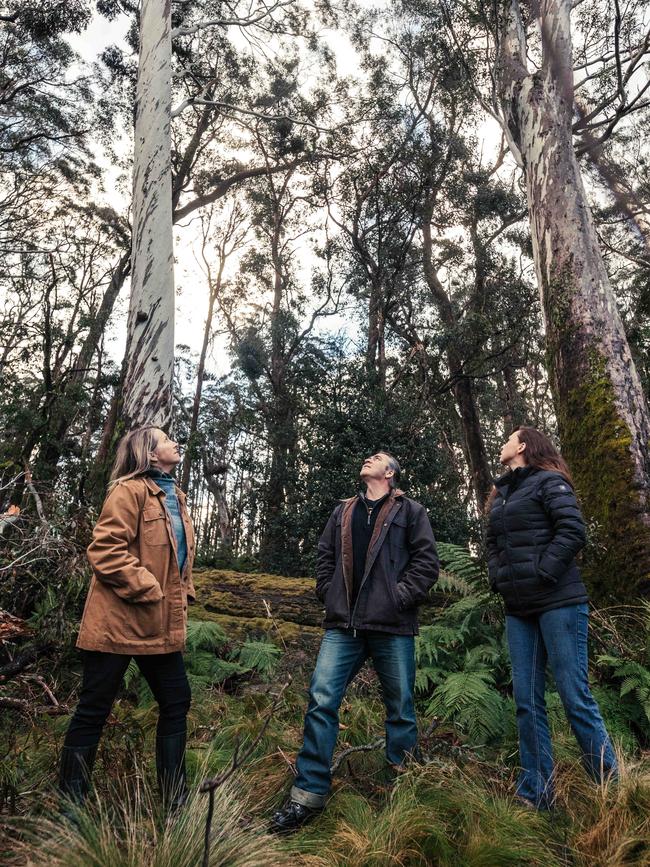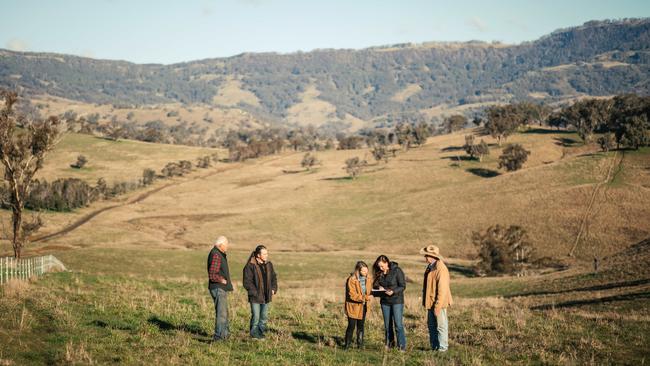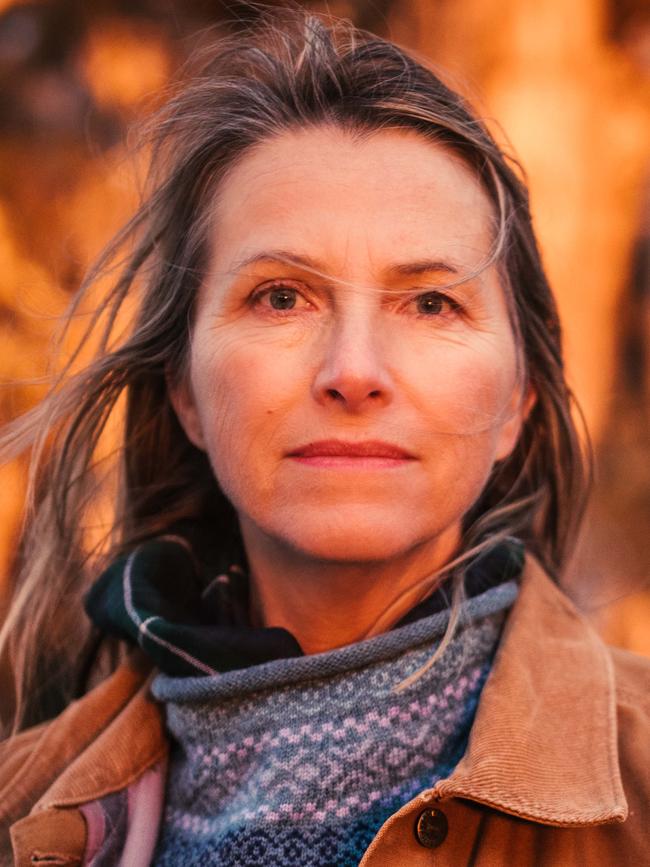Turbines as attractions not all hot air for tourist sector
Some say it’s absurd, but in regional Australia wind farms offer a new type of bucket-list appeal for curious visitors, along with clean energy.

Sue Robinson drives the 34-kilometre ridgeline that crowns her family cattle property south of Tamworth most weeks and never tires of the patchwork view that swoops and soars from valley to peak. “Just look at this,’’ she says, gazing off to the horizon. “It feels like you’re on top of the world.’’
This place, nestled between the Peel River and the Great Dividing Range, is surely one of the most scenic spots in the New England region, but that’s not its only notable feature. It’s reliably windy here, strong enough to blow the hat off the head of Sue’s husband, Jim. It got him thinking, “How would a wind farm go up here?”.
As plans took hold over months and then years to build a large-scale wind farm on the range near Hanging Rock, a hamlet eight kilometres south-east of the tiny one-pub town of Nundle, the Robinsons’ vision grew well beyond turbines. The infrastructure and lease payments associated with hosting the development would allow them to open up this elevated spot for others to enjoy, too.
Mountain biking and marathons, tourists in Polaris buggies, a colonial museum, a café. “This could be a huge tourist attraction,’’ Sue Robinson says, ticking off the jobs that could come with it, the new families who might move to the town, the economic boost.
Read more stories on the green economy in The List: Top 100 Green Energy Players, online or in print in The Australian on Friday.

A drive through Nundle – where signs supporting and opposing the proposed wind farm emblazon every other house – shows this is not a universal vision. It has deeply divided the town and is one of NSW’s most hotly contested renewable energy projects. At the time of going to print it was still grinding through the approvals process.
Tourism potential is a notion the wind farm’s opponents find absurd. Hills bristling with 64 turbines dotted across their scenic valley would harm tourism, not harness it, they argue; a position buttressed by high-profile doubters such as local federal member Barnaby Joyce, who has labelled wind farms disgusting. Former prime minister Tony Abbott once called them noisy, ugly, “dark satanic mills of the modern era”.
Tourism and turbines. They might go together like raw fish and sunshine for some. Others find them intriguing, futuristic monuments of modernity. So, is it possible for wind farms to not only coexist with rural tourism, but to boost it? Laura Dabner says yes.
Dabner has just driven a busload of New Zealand farmers around the Woolnorth Renewables precinct on the spectacular far northwest tip of Tasmania. “I get people who are curious, I get people who have some knowledge, but very rarely do I get people who hate wind farms,’’ she says. “I’d love to get more of them. Bring it on.’’
The 62 turbines of the two wind farms on the sprawling Woolnorth property – Bluff Point and Studland Bay – catch the Roaring Forties and there’s only a handful of days when it doesn’t blow, making this an ideal spot for the wind farm, one of the country’s largest when the second stage opened in 2004. About 2500 people a year make the journey to Woolnorth, about 130 kilometres from Burnie, for the 2.5-hour tour that takes in a number of features along the roiling coastline, home to Australia’s largest dairy farm.
Dabner’s business, Woolnorth Tours, takes visitors to the turbines for a short lesson in green energy before heading through cattle country to stunning Cape Grim, home to the cleanest air on the planet, according to the Baseline Air Pollution Station on the site. She says the wind farm is just part of the attraction. There’s no other way to access the private property at Cape Grim, famous for its beef and pristine air; notorious for the massacre of 30 Indigenous people by shepherds in 1828. The wind farm is part of the tapestry of the tour. Dabner is a straight shooter and spins a good yarn. The cows grazing under those turbines aren’t depressed, she tells guests. “They don’t have weird babies and their milk’s not sour.”
She talks about the mitigation measures to help birds avoid the spinning blades. It’s a hot issue in Tasmania; a study released last year found wind farms and transmission lines had killed or injured at least 321 eagles in 12 years. A proposed 100-turbine wind farm on Robbins Island, visible off Woolnorth, has been opposed by many groups, including prominent former Greens leaders Bob Brown and Christine Milne, worried about the visual impact and the effects on migratory birds.
Does Dabner see many dead birds on her tours? “That doesn’t happen. They use technology these days that looks in the sky and if a bird is predicted to use the thermals that will take it near a tower, they turn it off.”
As for the visual impact, she doesn’t see the problem and it should be noted there are no nearby towns looking out to the turbines. Dabner finds the steady rotational speed of the blades in this windy, wild spot to be relaxing “It’s calming, in a place that is often not [calm],’’ she says. “It’s an amazing sight.’’

In some regions, local tourist authorities promote wind farms as scenic attractions, such as South Australia’s “magnificent drive’’ past the Woakwine Range Wind Farm west of Mount Gambier, or the viewing platform at Crookwell near Goulburn in NSW. Visitors there can compare the old 45m-high turbines of the state’s first grid-connected wind farm, opened in 1998, with the bigger, newer turbines.
In Western Australia, the local tourism body says the sight of the Albany Wind Farm has become a popular tourism attraction: “Standing high on the coast, they make a fascinating landmark.’’ Other regional tourism bodies are now promoting public observation areas with information boards for interested travellers.
Near Canberra, the Run with the Wind half marathon through the Woodlawn Wind Farm at Tarago attracts hundreds of people each October with the promotional blurb: “Marvel at the might of the renewable energy giants, take in the stunning views …” In Scotland, hiking and mountain biking trails snake under turbines. In Wellington, New Zealand, the Tussock Ridge Farm tours combine sheep and cattle farming with wind farming on the cliffs overlooking the Cook Strait. In the US and UK, boat tours visit offshore turbines. Energy tourism is a nascent industry, to be sure. And the question remains: do wind farms turn more tourists away than they attract?
A 2021 industry-commissioned review into wind energy and tourism by Dr Barrie Shannon then from the school of humanities, creative industries and social science at the University of Newcastle found that adventure tourism, eco-tourism and educational tourism incorporating wind farm infrastructure are all emerging globally as opportunities for rural locations.
“This review demonstrates that tourists are not deterred by the presence of wind turbines and wind farms, and in fact are often drawn to them as points of interest. Opportunities for eco-tourism exist for communities in proximity to wind turbines, particularly if supporting infrastructure such as visitor centres, viewing platforms, hiking trails and other amenities are incorporated.”
He noted that the “sensible” placement of wind turbines is key to community acceptance: “They are more readily accepted when they are located away from areas of high aesthetic value.’’

Near the coast of southwest Victoria, Port Fairy man Tim Brady ran tours at nearby Codrington and Yambuk wind farms for 22 years, only ceasing to help his wife with her burgeoning business in town. “I stopped doing tours a few months ago and I’m still getting one or two calls a week from people trying to book a tour,’’ he says.
The wind farms, off the Princes Highway 20 minutes’ drive west of Port Fairy, certainly haven’t harmed tourism in the region. “Because we’re rural it gives people something else to do while they’re visiting the area,” he says. “It’s not killing tourism, no way; it’s adding to it.’’
His tours concentrated on the technical aspects of the wind farm but there were two questions commonly asked. “People would arrive and say, ‘Where are the dead birds?’ and I’d say that’s a fallacy. Then they’d say, ‘Where’s the noise?’ and I’d say, ‘You’re here, standing underneath one. That’s as noisy as it gets’.’’
Andrew Bray, the director of community advocacy organisation RE-Alliance, says he’s not surprised by people’s interest in wind farms: “They are fascinating; the turbines are so huge and when you get up close to them, so quiet. It takes you by surprise. That sort of discovery aspect is quite enticing.’’
Bray has been to Nundle, driven the range with the Robinsons, talked with the locals. For all the opposition to the Hills of Gold Wind Farm development, there are townsfolk who openly support the project.
“I visited a few times and I was struck that people who were supporting it were the ones talking about the future of the town and looking at ways to do interesting things,’’ he says.
Some locals say they welcome the economic boost from the community enhancement fund offered by the wind farm’s French multinational developer ENGIE, the pledged $3000 per turbine per year for the life of the project that will support local projects and organisations. They talk of the jobs it would bring, their worries about climate change and support for green energy and, yes, the tourism potential.
It’s also brought genuine anguish from residents worried about land-clearing and biodiversity impacts, its proximity to nature reserves and national parks, and the industrialisation of the landscape. Some can’t stand the thought of monstrous structures defiling the ridgeline and dwarfing the natural surrounds, as one landholder put it. One letter of objection said, “Tourists don’t come to Nundle for ‘tourist attractions’, they come because of the natural beauty of the area.”.
Another said: “Visually the proposal would totally change the step-back-in-time ambience and immersion in nature experience for residents and visitors. It will completely destroy the reason people choose to live in this area and deter tourists who won’t come ‘just to see another wind farm’.’’

Long-time opponent and local business owner Megan Trousdale said tourism ventures need tourism providers, many of whom live in Nundle because of its stunning, undeveloped natural environment.
“What this wind energy proposal has done is divide the community and people have lost motivation to continue investing in tourism,” says Trousdale, president of the local business tourism group. “Some have lost motivation to keep developing their operations.
“You can’t just ask ‘Can environmental tourism and wind farms co-exist?’ It’s what it does to the community that pre-exists.
“For years we will have to witness that mountain range being cleared of vegetation, the construction of roads on very steep country … it’s all the infrastructure that goes with it. People feel such a connection to that mountain range and it will be totally changed.’’
Sue Robinson walks the range of her property, past the grazing cattle and calves stretching out in the morning sun. She loves this place as much as anyone. The way she sees it, if the wind project goes ahead on their property, they’ll have the money to be able to share this special place, to run tours of the wind and cattle farms, to put in mountain biking paths, to buy the collection of a recently closed museum near Tamworth.
Where some residents see only harm coming from the project, she sees potential. Where some see eyesores, Robinson sees opportunity. “I truly believe it will bring prosperity to the community and everyone will benefit.’’





To join the conversation, please log in. Don't have an account? Register
Join the conversation, you are commenting as Logout